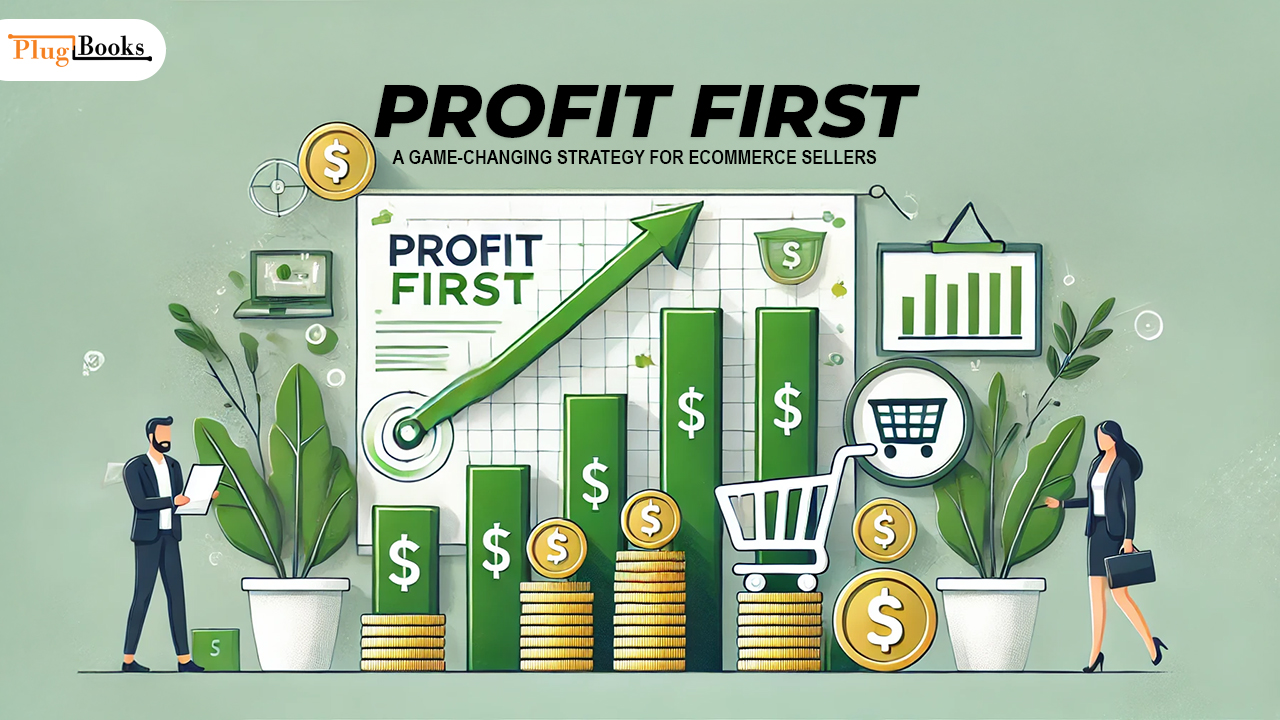Running an online store isn’t just about making sales—it’s about turning those revenues into real profit. If you’ve ever struggled with cash flow or wondered how to keep your business financially healthy, you’re not alone. That’s where the Profit First approach comes in. This game-changing method flips traditional accounting on its head, putting profit at the top of your priorities instead of treating it as what’s left over.
In this blog, we’ll break down what Profit First is, why it can be a game-changer for e-commerce sellers, and even show an example of how a multi-entity setup can work. Plus, we’ll touch on how tools like PlugBooks can make the whole process much smoother.
What is the Profit First Method?
Start by Paying Yourself First
The idea is simple: pay yourself first, rather than following the usual accounting method of subtracting expenses from revenue to see what’s left.
How the System Works
This approach uses multiple bank accounts for different purposes—like Profit, Taxes, Operating Expenses, and Owner’s Pay. Here’s how it looks in practice:
Revenue: As soon as money comes in, you allocate specific percentages to each category—profit, taxes, and so on.
Profit Allocation: A portion of every deposit goes straight into the “Profit” account, ensuring your business stays financially healthy.
Expenses: The remaining funds cover your day-to-day business expenses.
Owner’s Pay: Finally, you pay yourself fairly as the business owner.

Focus on Profitability, Not Just Survival
This method helps entrepreneurs concentrate on true profitability instead of just keeping the business afloat. It guarantees that you always have funds ready to reinvest in your company while paying yourself fairly.
Multi-Entity Strategy
Using a profit-first mindset across multiple companies, the same process can be applied to ensure that each entity remains profitable. This makes it easier to manage finances across a multi-entity structure without losing sight of your bottom line.
Why Profit First Method Should Be Used by E-Commerce Sellers
1. Improved Monetary Situation
Cash flow can be tricky for growing e-commerce businesses. By prioritizing profit and covering essential expenses, this approach prevents overspending. Allocating a percentage of every sale to profit boosts long-term cash flow. A multi-entity setup shows how several businesses can stay financially independent while improving overall stability.
2. simplified cash flow control
For e-commerce businesses, managing cash flow—especially with inventory management, marketing, and other variable costs—can be challenging. Using multiple accounts makes it easier to track expenses and plan for reinvestment. A multi-entity setup shows how even complex business structures can maintain healthy cash flow.
3. Motivating to Reduce Unnecessary Expenses
Focusing on profit encourages e-commerce sellers to take a closer look at their expenses, often uncovering unnecessary or duplicate costs. This not only boosts profitability but also fosters better financial discipline. Using a multi-entity setup, sellers can optimize spending across several businesses, keeping each one lean and efficient while staying on top of eBay 1099-K reporting.

Using Profit First for Your Online Store
Adopting the Profit-Led approach need not be taxing. This detailed manual will enable you to apply it in your online store:
First, create many bank accounts.
First, you should open many bank accounts—at least five. Here is how you ought to split your income:
- Your company’s profit goes here, the 10% profit account.
- Set aside a bit for your personal pay from the 15% owner’s pay account.
- Save money for taxes to help to prevent surprises at the end of the year.
- Operating expenses, or seventy percent, are the funds you expend running the company.
Every company entity in a Profit-Led multi-entity structure should have separate accounts. For instance, different allocations would be needed by a parent firm and its subsidiaries to prevent uncertainty and guarantee that every organization stays profitable.
Second Step: Distribute Your Income
Based on the percentages you have selected, divide every dollar you get among these accounts. If you make $10,000 a month, for instance, you would allocate:
- $1000 to the Profit Account
- $1,500 into the Owner’s Pay Account
- $1,500 straight to the Tax Account
- Six thousand to cover running expenses
This basic distribution guarantees that, even in times of great expenditure, you are always giving profit top priority. Under a Profit multi-entity structure, this distribution can be done for every entity separately so that profits across all of your portfolio remain constant.
Third step: Review often.
You might have to change the percentages you divide among every account over time. As your company expands, for instance, you could choose to allocate more for profit or running expenses. Quarterly review your allocations to make sure you are on target.
This reevaluation becomes even more important in a Profit-Focused multi entity structure since different businesses may have different cash flow requirements.
How Plugbooks Might Support Online Sellers Using Profit First
Implementing a profit-prioritized system can be tedious, especially for growing e-commerce businesses. That’s where PlugBooks comes in.
Designed for e-commerce, PlugBooks automatically connects with Xero and QuickBooks, as well as platforms like Shopify, WooCommerce, Amazon, and eBay, to streamline accounting tasks. It tracks income and expenses, helping you effortlessly allocate funds to your profit-focused accounts.
Even across multiple entities, PlugBooks can suggest the right percentages for profit, taxes, expenses, and owner’s pay, while generating clear, easy-to-read financial reports.
By automating these processes, PlugBooks reduces errors, ensures accurate fund distribution and tax compliance, and frees you to focus on growing your business.

Typical Difficulties and Their Solutions
Though Profit First is a great approach, it has certain difficulties. These are some typical obstacles e-commerce vendors run across and how to get above them:
1. Initial Adjustment Period
Switching to multiple account allocations can feel challenging at first. Start small and gradually adjust your percentages to make the transition smoother. In a multi-entity setup, this phase may take longer as you balance the needs of each business.
2. Managing Lean Months
During slow months, it may seem difficult to set aside profit. Even small allocations build the habit of prioritizing profitability. In a multi-entity structure, some businesses may contribute more while others scale back, but all stay focused on maintaining financial discipline.
In essence
For e-commerce sellers aiming to boost profitability and manage cash flow, a profit-prioritized system can be a game-changer. Using tools like PlugBooks automates financial management, letting you focus on growing your business.
Remember, success isn’t just about generating revenue—it’s about turning it into lasting profit. A multi-entity setup shows how you can expand multiple profitable businesses efficiently.



